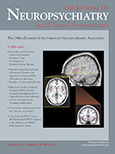Marked Exacerbation of ADHD After Onset of Inhalant Use: A Case Report
To the Editor: Inhalants are breathable chemical vapors/gases abused for their psychoactive effects, with toluene being the most common active constituent. Few reports have described psychiatric complications in relation to inhalant use.1,2 None of them have reported a link with attention-deficit/hyperactivity disorder (ADHD).
Case Report
A 12-year-old boy was brought by parents with the chief complaint of petroleum inhalation for 1 year. The patient began inhalant use (cooking gas for a few weeks followed by a shift to petroleum use) at the age of 11 years. He reported an instant euphoria and drowsiness. Over the next 2–3 months, the amount and frequency of use increased (3–4 times/day), and he started experiencing withdrawal and cravings. Around this time, the parents noticed that the patient had become extremely fidgety, restless, and inattentive at home and school. He would make frequent mistakes in work and often interrupt other students. He was more active and impatient than previously. This was not confined to periods of intoxication, but persisted throughout the day for nearly 9–10 months. Eventually, he dropped out of school.
A childhood history revealed the patient to be mischievous and slightly overactive as a child. He would have difficulty waiting for his turn and was inattentive in class since early childhood. However, the need for formal treatment was never felt. Physical examination revealed no abnormality (except for a body mass index of 14.7 kg/m2). A mental state examination revealed significantly increased psychomotor activity, poor eye contact, euthymic mood, and poor attention and concentration.
The patient was observed in a ward setting for the next 4 weeks without introduction of specific medications, during which the baseline score of the revised Conners’ Parents Rating Scale (46) showed no change. Abstinence from toluene was repeatedly confirmed by urinalysis. Thereafter, atomoxetine (18 mg/day) was initiated, and the patient showed an 80% reduction in baseline Conners’ Parents Rating Scale scores over next 3 weeks. A final DSM-IV-TR3 diagnosis of inhalant dependence and ADHD was made before discharge. Currently, he is in regular outpatient follow-up for 6 months, in remission from ADHD symptoms, and maintaining abstinence.
Discussion
This is the first case report to suggest that inhalant use can significantly worsen the symptoms of ADHD. It is interesting to note that once the disease condition exacerbated, it appeared to run a relatively independent course, with no remission on abstinence. An alternative theory could be that 1 month of observation was not sufficient to see a remarkable change, although even a downward trend was not evident in Conners’ Parents Rating Scale scores. ADHD is a known risk factor for initiation of child/adolescent substance use, and management focused on both conditions.
The underlying mechanisms linking chronic inhalant use to ADHD symptoms can only be hypothesized at best. Preclinical studies examining the effects of chronic inhalant exposure have indicated long-term alterations in the N-methyl-d-aspartate (NMDA) receptor function.4 The NMDA receptor abnormalities, along with a dysfunctional interaction between glutamate and dopaminergic systems, has been implicated in the etiopathogenesis of ADHD.5 Furthermore, medications for ADHD also appear to act through NMDA receptor antagonism.5
This case report highlights the need to pay closer attention to the link between inhalant use and ADHD.
1 : Adolescent substance abuse and psychiatric comorbidities. J Clin Psychiatry 2006; 67:e02Crossref, Medline, Google Scholar
2 : Psychiatric disorders in inhalant users: results from The National Epidemiologic Survey on Alcohol and Related Conditions. Drug Alcohol Depend 2007; 88:146–155Crossref, Medline, Google Scholar
3
4 : The last decade of solvent research in animal models of abuse: mechanistic and behavioral studies. Neurotoxicol Teratol 2006; 28:636–647Crossref, Medline, Google Scholar
5 : Dopamine and glutamate interactions in ADHD: implications for the future neuropharmacology of ADHD, in Attention Deficit Hyperactivity Disorder in Children and Adolescents. Edited by S Banerjee. Croatia, In Tech Publishers, 2013Google Scholar



